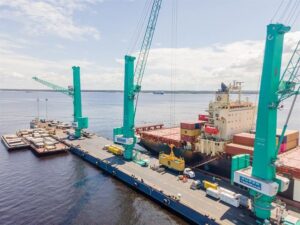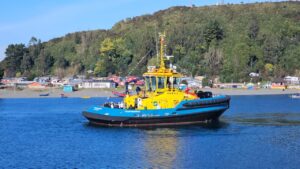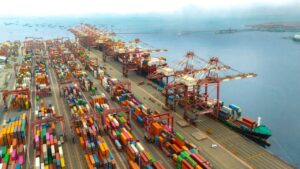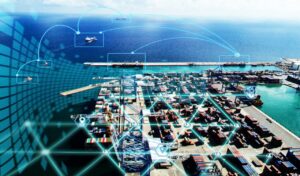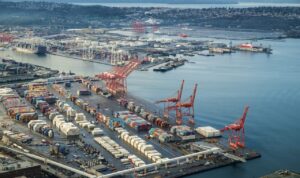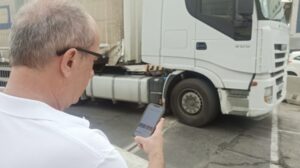Digital perception radar technology could be the next major smart port innovation and help stakeholders across the maritime industry increase efficiency and safety.
Uhnder Inc. unveiled a digital perception radar sensor solution for use in autonomous trucks operating in container ports on 21 April 2021.
The radar sensors are an upgrade on the analogue ones traditionally used in ports and could accelerate the flow of containers from the ship to the hinterland and beyond. They could even be used to automate vessel docking and goods storage.
Speaking exclusively to PTI, David Loadman, Vice-President, Sensors Business Unit, Uhnder, said, the technology’s potential is not limited to container ports and terminals.
“Everybody is very aware of the very large market for radar, sensors for automotive vehicles,” Loadman explained.
“What we have found is that the market for moving goods and materials is also very large and what we’re seeing is that the autonomy is needed at every step in the supply chain.”
According to Loadman, Uhnder could one day roll out the technology across the supply chain and solve some of the biggest logistical challenges. These include improving efficiency in the ‘last mile’ by automating vehicles such as delivery vans and drones, all of which need sensor solutions to support full autonomy.
“We actually view the entire supply chain automation as a very large growing market, we are very focused on that area.”
A wholescale upgrade of port operations
Initially designed for container handling autonomous vehicles, the technology could one day be used in multiple applications, such as rubber tyred gantry (RTG) cranes, and even help vessels dock and undock safely.
“At some point in the future, as we work with various countries and understand the regulatory requirements for ships, we will be able to use the radar technology to assist with the safe docking and undocking of the ships themselves,” Loadman said.
However, to date Uhnder has not spoken to carriers because it still needs to “better understand the regulations” and how well the radar technology will perform on the water. Nevertheless, Loadman expects the company to do so once its current pilot projects are complete.
Additionally, there are signs it can work in warehouses, which Loadman described as a “key opportunity” for Uhnder because the technology can help avoid collisions and move palletised goods more freely.
Loadman said that the radar sensor technology allows autonomous vehicles to operate “within five centimetres of accuracy” which ultimately increases operational efficiency.

Analogue radars “tend to degrade” and decline in performance over time, particularly when in such close proximity to other radars, which interferes with signals.
“In order to fully automate these trucks to move containers, you need to have a large number of radar sensors distributed the vehicle, so that you can get a full 360-degree field of view.
“A typical installation means that you have 12 radars on a vehicle at any one time. Each berth within a port can be served by as many as 200 trucks, which means you can have 2,000 radars operating in a confined environment.
“One of the big advantages of our technology is that we use a digitally modulated signal for each of our transmitters, which is very similar to the coding you find in a cell phone.”
This allows Uhnder’s radars to operate in the presence of many others on many single vehicles, which are subsequently able to seamlessly operate together.
Pinpoint accuracy and future deployment
A further complication of current radar sensor technology in maritime, according to Loadman, is the high amount of metal containers and various cranes which cause reflections and signal interference.
The ever-increasing fleets of equipment make deploying wireless technology a challenge for ports and terminals, especially those looking to become safer and more efficient through digitalisation.
Uhnder’s radar sensor technology is being piloted by China Merchants Port (CMPort) in a fleet of autonomous trucks at the Mawan Smart Port in Shenzhen and expects to complete its project later in 2021.
Loadman told PTI that CMPort will measure the pilot by two key metrics – reliability and accuracy – both of which are vital to improving safety and efficiency. The project will test the radar technology’s ability to work in a variety of weather conditions, including at night.
“The one concern [from CMPort] is ensuring that the solution had a high degree of uptime and the second is accuracy.”
Ports looking to utilise this technology need to first understand their capabilities and if they can integrate the sensors onto their vehicles. If a port is going to deploy a fleet of purpose-built vehicles, then it also needs to look into supportive infrastructure, such as charging and maintenance.
Loadman said that after the pilot at CMPort, Uhnder will look to expand in the Middle East, where there is a “tremendous concentration of ports”, and North America and Europe. Here, the company’s aim will be to explore intermodal hubs and the rail part of the supply chain.


